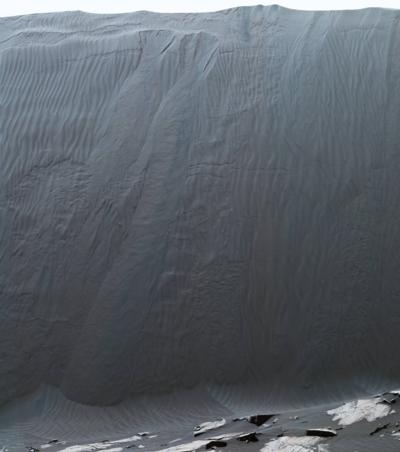Fri, Jan 08, 2016
Observes Slip Face Of Dune For The First Time
NASA's Curiosity Mars rover, partway through the first up-close study ever conducted of extraterrestrial sand dunes, is providing dramatic views of a dune's steep face, where cascading sand has sculpted very different textures than the wavy ripples visible on the dune's windward slope.

Researchers are using Curiosity to examine examples of the Bagnold Dunes, a band of dark sand dunes lining the northwestern flank of Mt. Sharp, the layered mountain the rover is climbing. A characteristic that sets true dunes apart from other wind-shaped bodies of sand, such as drifts and ripples previously visited by Mars rovers, is a steep, downwind slope known as the slip face. Here, sand blowing across the windward side of the dune suddenly becomes sheltered from the wind by the dune itself. The sand falls out of the air and builds up on the slope until it becomes steepened and flows in mini-avalanches down the face.
The mission's dune-investigation campaign is designed to increase understanding about how wind moves and sorts grains of sand, in an environment with less gravity and much less atmosphere than well-studied dune fields on Earth. The Bagnold Dunes are active. Sequential images taken from orbit over the course of multiple years show that some of these dunes are migrating by as much as a yard, or meter, per Earth year.
Curiosity has not caught a sand slide in action, but the rover's images of the Namib Dune slip face show where such slides have occurred recently. These dunes likely are most active in Mars' southern summer, rather than in the current late-fall season.

A few days of rover operations were affected in December due to an arm-motion fault, diagnosed as a minor software issue. Normal use of the arm resumed Dec. 23.
Curiosity has been working on Mars since early August 2012. It reached the base of Mount Sharp in 2014 after fruitfully investigating outcrops closer to its landing site and then trekking to the mountain. The main mission objective now is to examine successively higher layers of Mount Sharp.
(Images provided with NASA news release)
More News
From 2023 (YouTube Version): Legacy of a Titan Robert (Bob) Anderson Hoover was a fighter pilot, test pilot, flight instructor, and air show superstar. More so, Bob Hoover was an i>[...]
Get The Latest in Aviation News NOW on Instagram Are you on Instagram yet? It's been around for a few years, quietly picking up traction mostly thanks to everybody's new obsession >[...]
Aero Linx: B-52H Stratofortress The B-52H Stratofortress is a long-range, heavy bomber that can perform a variety of missions. The bomber is capable of flying at high subsonic spee>[...]
Altimeter Setting The barometric pressure reading used to adjust a pressure altimeter for variations in existing atmospheric pressure or to the standard altimeter setting (29.92).>[...]
"Knowing that we play an active part in bettering people's lives is extremely rewarding. My team and I are very thankful for the opportunity to be here and to help in any way we ca>[...]
 Classic Aero-TV: Remembering Bob Hoover
Classic Aero-TV: Remembering Bob Hoover ANN FAQ: Follow Us On Instagram!
ANN FAQ: Follow Us On Instagram! ANN's Daily Aero-Linx (05.15.24)
ANN's Daily Aero-Linx (05.15.24) ANN's Daily Aero-Term (05.15.24):Altimeter Setting
ANN's Daily Aero-Term (05.15.24):Altimeter Setting Aero-News: Quote of the Day (05.16.24)
Aero-News: Quote of the Day (05.16.24)




